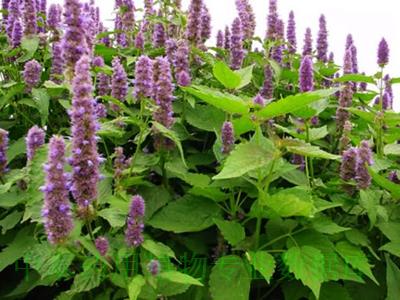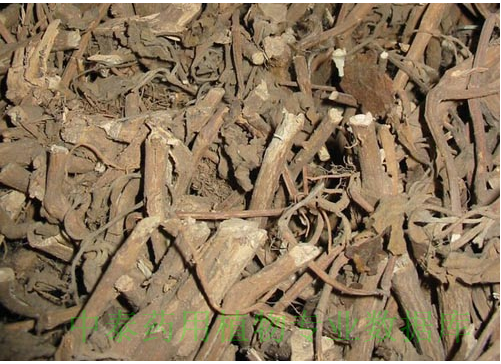| [English Name] | Cablin Potchouli Herb | |
| [Chinese Name] | 广藿香地上部分 | |
| [Pinying Name] | Guanghuoxiangdishangbufen | |
| [Latin Name] | Herba Pogostemonis | |
| [Genera] | Labiatae | |
| [Efficacy] | huashiyao | |
| [Pictures] | Plant picture | Drug picture |

|

|
|
| [Alias] | ||
| [Source] | Pogostemoncablin(Blanco)Benth.[MenthacablinBlanco] | |
| [Plant morphology] | ||
| [Distribution] | ||
| [Gathering and processing] | ||
| [Characteristics] | ||
| [Ecology] | It prefers high temperature and moist climate, average temperature between 24 to |
|
| [Chemical composition] | This plant contains flavonoids: apigetrin, apigenin-7-O-β-D-(6′′-p-coumaroyl)-glucoside, ombuin, rhamnetin, apigenin, pachypodol[1,5]; essential oils: β-caryophyllene, δ-cadinene, β-elemene, α-guaiene[1,2], methyl acetate, 3-methyl butanone, 3-methyl-3-butenone[1,6], δ-guaiene (α-bulnesene), α-patchoulene, β-patchoulene, seychellene, patchouli alcohol[1,4], patchoulane,1,12-diol[1,3], pogostone[1,3,4]. | |
| [Pharmacological activities] |
1. The inhibitory effect:The patchouli ketone have a significant inhibition on long white with beads, bacteria, Cryptococcus neoformans , and Rhizopus nigricans fungi . It also have a certain degree of inhibition [1] towards alpha hemolytic streptococcus and other bacteria. Patchouli leaves Juice of Staphylococcus aureus, Staphylococcus and Bacillus subtilis growth inhibition determined[2]. Its juice ear drops (4 drops/3 times a day) treatment of Staphylococcus aureus-induced acute experimental guinea pig otitis externa [3]. The patchouli ketone can inhibit the length of the penicillium mold and can be used for corrosion protection of the oral solution [4]. 2. Calcium contributions effect: the patchouli water extracts of isolated guinea pig colon induced by high K with shrink significantly inhibited, that calcium antagonism 3×10-4g/ml, the inhibition rate of 17%, 30 × 10-4g/ml, the inhibition rate of 91%. The active ingredient of patchouli alcohol, calcium antagonism antagonist parameters (PA2) value of 5.95, IC50 of 4.7×10-5mol/L Patchouli alcohol on Ca2+-induced contraction of the rat main artery, verapamil heart, the dose depends on antagonism [5]. |
|
| [Clinical trial] | The treatment of chronic sinusitis :Guanghuoxiang decoction:Guanghuoxiangye(Cablin Potchouli Herb) 5kg, Fresh pigbile 1.5 kg add honey, and add sugar were made into a pill, 10 ~ 15 g per time, 2 ~3 times per day, with 1% ephedrine or 20% heartleaf houttuynia herb to dropletnose, 10 days as one course of treatment. A total of 50 cases were treated for 2 ~ 5 course, 15 cases were cured (30%), 30cases were improved (60%), 5 cases were invalid (10%), the total effective ratewas 50% [1]. |
|
| [Properties] | ||
| [Medical and other Uses] | ||
| [Dosage] | ||
| [Cautions] | ||
| [Traditional usage] |
1.Common cold with headache, aversion cold with fever, dyspnea with cough, cold sensation and pain in chest and abdomen, regurgitation with vomiting, diarrhea due to stagnation of vital energy, rugitus, malignant malaria, puffiness on the whole body, antenatal and puerperal pricking pain caused by stagnation of qi and blood, infantile malnutrition 2.Vomiting and diarrhea in summer 3.Can be taken at any time 4.Malaria 5.Removing halitosis 6.Infantile ulcerative gingivitis with pus, halitosis and swollen mouth 7.Threatened abortion, vomiting induced by disorder ascending and descending of qi 8.Chilblain 9.Bleeding caused by incised injury |
|
| [Toxicological studies] | ||
| [Pharmaceutical preparations] |
1. Yinlianqinggan Mixture:orientalwormwood, bupleurum root, curcuma root, isatis root, male fern rhizome,hedyotis, barbated skullcup herb, giant knotweed rhizome, paris root, poria,agastache, amomum fruit, fortune eupatorium herb, white peonyroot(stir-frying), chinese angelica root, red sage root, safflower, hirsuteshiny bugleweed herb, amber. 2. ShuganHewei Pill:bupleurumroot, nutgrass flatsedge rhizome(stir-frying with vinegar), finger citron,curcuma root, aucklandia root, lindera root, tangerine peel, arecaseed(stir-frying), radish seed, white peony root, white atractylodesrhizome(stir-frying), agastache, stir-fried liquorice. |
|
| [References] |
Chemical Composition: [1] State Chinese Medicine Administration Bureau" Chinese Materia Medica" Editorial Board . Chinese Materia Medica [M]. Shanghai: Shanghai Science And Technology Press,1999, Seventh:130-134( Total6149).[2]M Rober N.J Org Chen1972,37(18):2871 [3] Guangdong Province Analysis And Testing Research Institute Room. Chinese Science Bulletin,1977,22(7):318 [4]Guan L, Et Al.CA.1993118:19183p. [5itokawah, Et Al. Chem Pharm Bull,1981,29(1):254 [6] Li Hongjun, Et Al. Analysis Chemistry,21(1):117 Pharmacological Effect: [1] Yang Zanxi, And So On. Chinese Science Bulletin,1977.22(7):318 [2] He Kunyao, .J Chin Med,1992.2(2):59 [3] He Kunyao, .J Chin Med,1992.2(2):73 [4]Kong Tingxing, Chinese Herbal Medicine,1984,15(3):16 [5]Kazuo I, Et Al. Chem Pharm Bull,1989,37(2):345 Clinical Trials: [1] Zhou Xiehe,Etc. Shanxi Traditional Chinese Medicine,1985,6(12):557 |
|